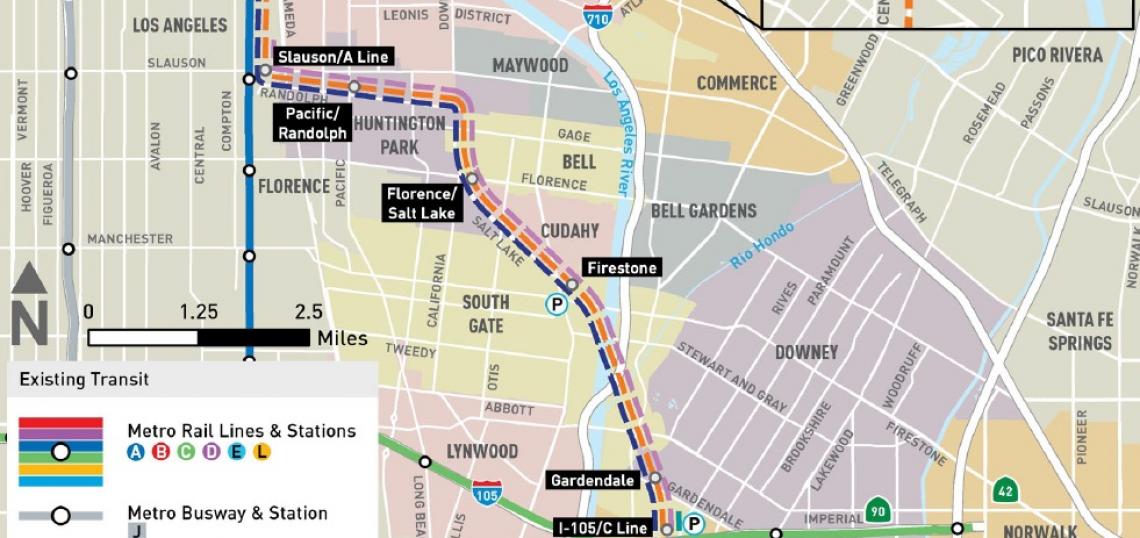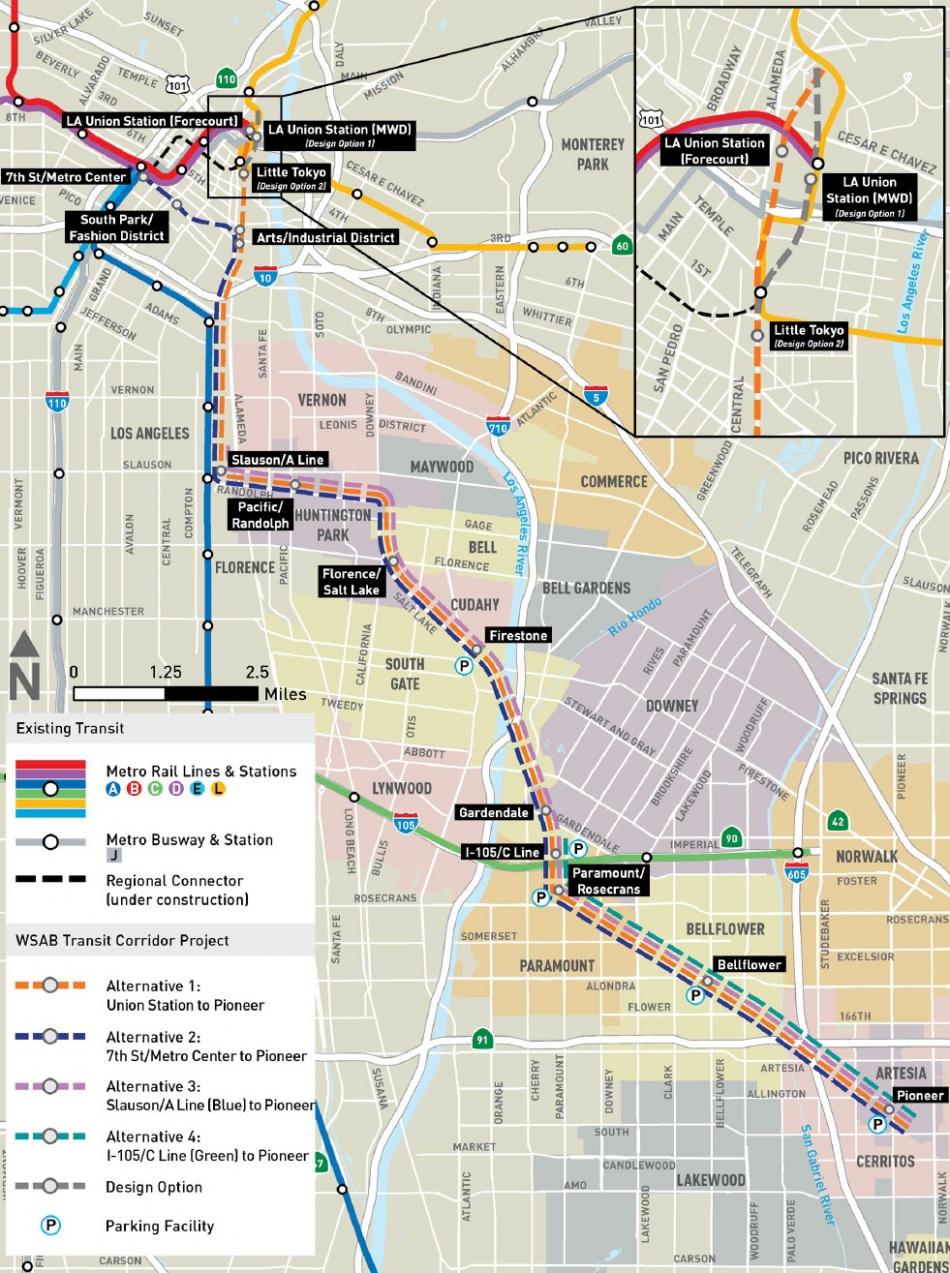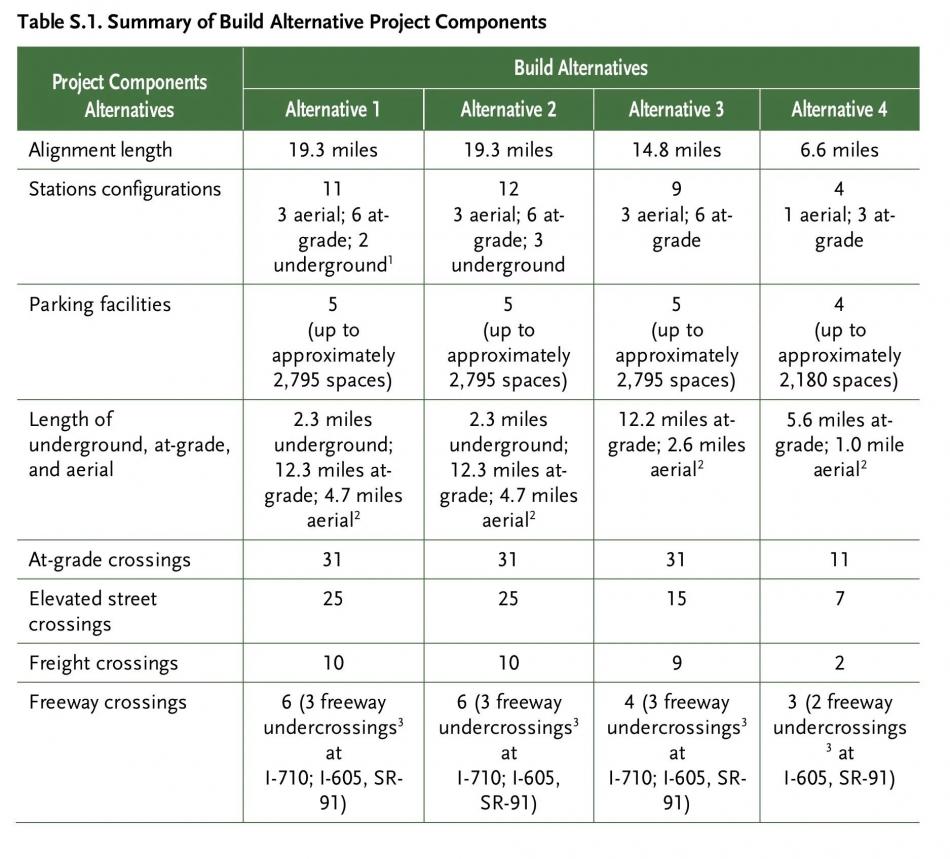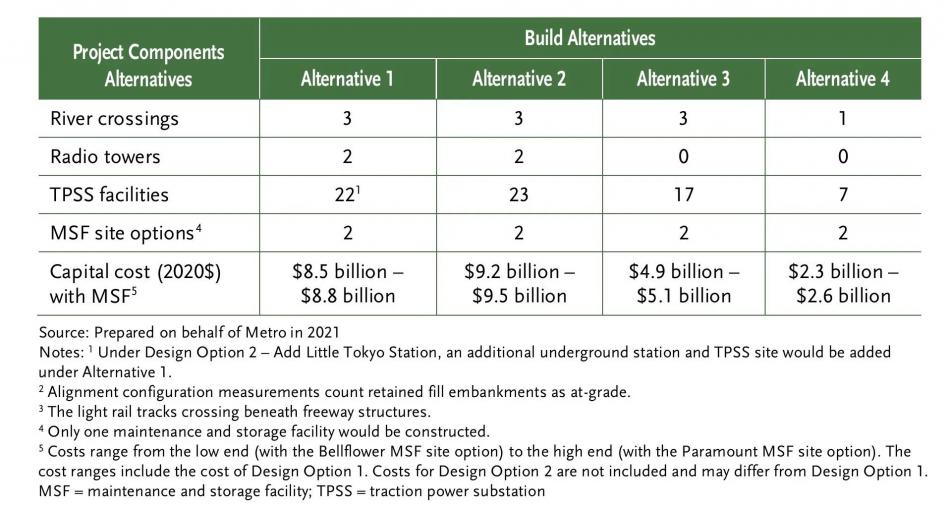A draft environmental impact report published last week by Metro details new build options for a proposed light rail line that would connect southeast Los Angeles County with Downtown.
The proposed West Santa Ana Branch (WSAB), a project which is set to receive roughly $4 billion in funding via Measure M, would span a roughly 19-mile corridor serving the cities of Los Angeles, Vernon, Huntington Park, Cudahy, Bell, South Gate, Downey, Cerritos, Bellflower, and Artesia, as well as the unincorporated community of Florence-Firestone.
Metro's environmental study considers four potential build options for the WSAB, two of which differ based on the project's eventual northern terminus, and another two which would break the project into phases. South of Downtown, each of the alternatives call for identical alignments, routing trains on existing freight-rail corridors and on a former Pacific Electric railway right-of-way between Paramount and the project's southern terminus at Pioneer Boulevard in Artesia. The project area is home to more than 1.4 million residents and 618,000 jobs, with an average population density and transit mode share that surpass those of Los Angeles County as a whole.
Alternative 1, the first of the two options which calls for completing the project in one fell swoop, calls for the project's northern terminus to land at Union Station, where the WSAB would connect with Metro subway and rail lines as well as Metrolink trains and various local and regional bus lines. Design options under Alternative 1 include two possible approaches to Union Station (either a terminus below its forecourt on Alameda Street or behind the Metropolitan Water District building in its rail yard) and an optional station in Little Tokyo.
A ridership forecast included with the environmental study estimates that the Union Station-to-Artesia alignment would attract approximately 61,000 daily weekday passengers under conditions expected in the year 2042. Due to the length of the alignment, as well as large stretches of below-grade and above-grade track, construction costs are expected to range from $8.1 billion.
Alternative 2, the other full-build option, calls for a northern terminus in a new subway stop at 8th and Figueroa Streets in the Financial District, which would connect to 7th Street/Metro Center station through a new pedestrian tunnel. In addition to the 7th/Alameda Street station envisioned in both alternatives, Alternative 2 would also include a third Downtown stop at 8th and Los Angeles Streets.
Due to its connection to 7th Street/Metro Center - the busiest transit stop in Metro's system - Alternative 2 would command the highest ridership numbers out of the four alternatives under study, with nearly 83,000 weekday riders expected in 2042. However, with a potential price tag between $8.8 billion, it also ranks as the most expensive option under consideration.
The third alternative, which has been recommended by staff for selection as the "locally preferred alternative," calls for building an initial phase of the WSAB between Slauson Avenue in unincorporated Florence-Firestone and Artesia. The 14.8-mile route would fall four miles short of Downtown Los Angeles, but still offer connections to the A and C Lines.
With a lack of a direct connection to Downtown, Alternative 3's ridership forecasts are lower than its two lengthier counterparts, with a projected 31,000 weekday passengers by the year 2042. However, delaying the construction of extensive above-grade and below-grade track through South Los Angeles and Downtown would result in a lower price tag: approximately $4.4 billion.
Alternative 4 would further truncate the amount of track built in the initial phase of the WSAB, calling for just 6.6 miles of new track between the C Line and Artesia. This option would attract an estimate 11,000 weekday passengers, the lowest of the four alternatives, at an estimated cost of $1.9 billion.
Building the West Santa Ana Branch in segments could allow for service on at least part of the corridor to begin as early as 2028. However, the full 19-mile line is not scheduled for completion until 2041, per the Measure M expenditure plan.
While staff have recommended construction an initial segment of the WSAB between the A Line and Artesia, a final decision on what will be built is subject to a vote by the Metro Board of Directors. According to The Source, opportunities to solicit more information and provide feedback will be made available through community meetings at the following dates and times:
Thursday, August 19, 2021
6 p.m. to 8 p.m.
Zoom Link: tinyurl.com/3f88s7hf
Call-In Number: 213.338.8477
Meeting ID: 980 0887 2988
Tuesday, August 24, 2021
Noon to 2 p.m.
Zoom Link: tinyurl.com/4asvr4pz
Call-In Number: 213.338.8477
Meeting ID: 986 2612 6175
Saturday, August 28, 2021
10 a.m. to Noon
Zoom Link: tinyurl.com/4df3b3rk
Call-In Number: 213.338.8477
Meeting ID: 986 4545 5706
Information is also available on the project's official website (metro.net/WSAB) or via e-mail at wsab@metro.net.
- West Santa Ana Branch (Urbanize LA)









